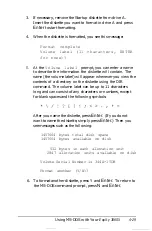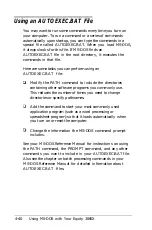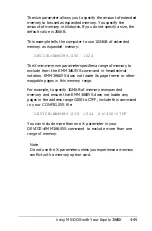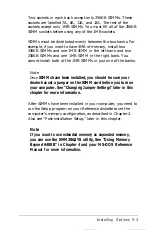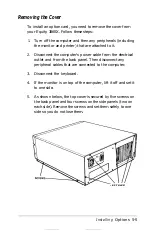
If you have a hard disk and you installed MS-DOS according
to the instructions in your MS-DOS Installation Guide,
MS-DOS automatically sets a path to the directory that
contains the MS-DOS commands and the MS-DOS
command prompt displays the current drive and directory.
Creating an AUTOEXEC.BAT File
Here is an example of an AUTOEXEC.BAT file:
PATH
C:\;C:\DOS;C:\WP
PROMPT $P$G
The first line tells MS-DOS to look for programs or batch files
in the root directory, the DOS directory, and your word
processing directory. This way you can run programs in those
directories without having to specify pathnames in the
commands. The second line changes the MS-DOS command
prompt so that it displays your current directory.
To create an AUTOEXEC.BAT file, you can use any command
or program that lets you create a text-only file. If you have a
word processing program that can save a file as a text-only file
(sometimes called an ASCII text file), you can use that program
to create your AUTOEXEC.BAT file. Name the file
AUTOEXEC.BAT and store it in the root directory of the hard
disk or diskette from which you load MS-DOS.
Using MS-DOS with Your Equity 386SX
4-41
Summary of Contents for Equity 386SX PLUS
Page 1: ...m u cl3 0 z E 5 J I 1 al y 8 c 7 5 w ii u l X ...
Page 4: ...EPSON E Q U I T Y 3 8 6 S X User s Guide Y19299100100 ...
Page 20: ...6 Introduction ...
Page 38: ...1 18 Setting Up Your System ...
Page 69: ......
Page 70: ...2 32 Running the Setup Program ...
Page 96: ... 7 R _ ri h 14 3 26 Using the Equity 386SX ...
Page 168: ...5 26 dling Options ...
Page 192: ...B 4 Power on Diagnostics ...
Page 232: ...C 40 Performing System Diagnostics ...
Page 246: ... D 14 Physically Formatting a Hard Disk ...
Page 250: ...E 4 Hard Disk Drive Types ...
Page 282: ...8 I n d e x ...
Page 284: ......



